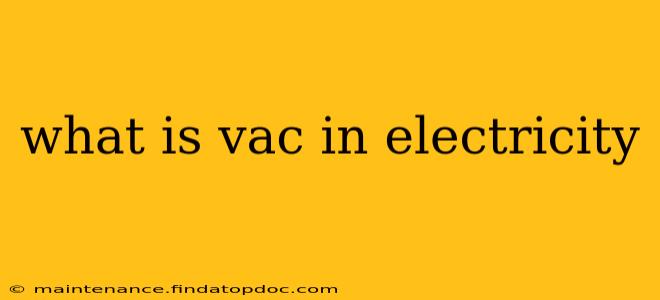VAC, or volts AC, is a crucial term in electricity representing the alternating current (AC) voltage in a circuit. Understanding VAC is fundamental to working safely and effectively with electrical systems. This article will delve into what VAC means, its relationship to other electrical concepts, and answer common questions surrounding this important term.
What Does VAC Stand For?
VAC stands for Volts Alternating Current. It measures the electromotive force or potential difference between two points in an AC electrical circuit. Unlike direct current (DC), where the flow of electrons is constant in one direction, AC voltage and current periodically reverse direction. This cyclical reversal is what differentiates AC from DC and is crucial in how we use electricity in our homes and industries.
What is the Difference Between VAC and VDC?
The key difference lies in the nature of the current:
- VAC (Volts AC): Alternating current, where the direction of electron flow periodically reverses. This is the type of electricity supplied to our homes and businesses from the power grid.
- VDC (Volts DC): Direct current, where the flow of electrons is constant in one direction. This type of current is commonly found in batteries and some electronic devices.
While both measure voltage, their applications and characteristics differ significantly. Using AC or DC incorrectly can damage devices or pose safety hazards.
How is VAC Measured?
VAC is measured using a voltmeter, specifically one designed for AC voltage measurements. The voltmeter is connected across the two points in the circuit where the voltage needs to be measured. The reading displayed will be in volts (V), often expressed as VAC to clearly indicate it's an alternating current voltage.
What are Common VAC Values?
The common household voltage varies globally. In many parts of North America, the standard voltage is 120 VAC. In other regions, such as much of Europe and Asia, the standard voltage is 230 VAC. Different appliances and devices are designed to operate at specific voltage levels, making it crucial to use the correct voltage for safety and proper functioning.
What is the Relationship Between VAC, Amps, and Watts?
VAC, amps (A), and watts (W) are interconnected concepts in electrical circuits. The relationship is expressed through the following formula:
Power (Watts) = Voltage (Volts) x Current (Amps) or W = V x A
This means that the power consumed by a device is directly proportional to both the voltage and the current. A higher voltage or current will result in higher power consumption.
What is the Difference Between Voltage and Current?
While often used interchangeably in casual conversation, voltage and current are distinct electrical quantities:
- Voltage (VAC or VDC): The electrical potential difference between two points, analogous to the pressure in a water pipe. It's the "push" that drives the current.
- Current (Amps): The rate of flow of electric charge, analogous to the flow rate of water in a pipe. It's the actual movement of electrons.
What Happens if I Use the Wrong VAC?
Using the incorrect VAC can have several consequences:
- Damage to appliances: Applying a voltage higher than the rated value can burn out components, while a lower voltage may prevent the appliance from functioning correctly or damage it over time.
- Safety hazards: Incorrect voltage can lead to overheating, sparking, and even fire.
- Malfunctioning of devices: Appliances and electronics may fail to function correctly or exhibit erratic behavior.
Understanding VAC is crucial for safe and efficient use of electrical systems. Always check the voltage rating of appliances before connecting them to a power source. If you have any doubts, consult a qualified electrician.
